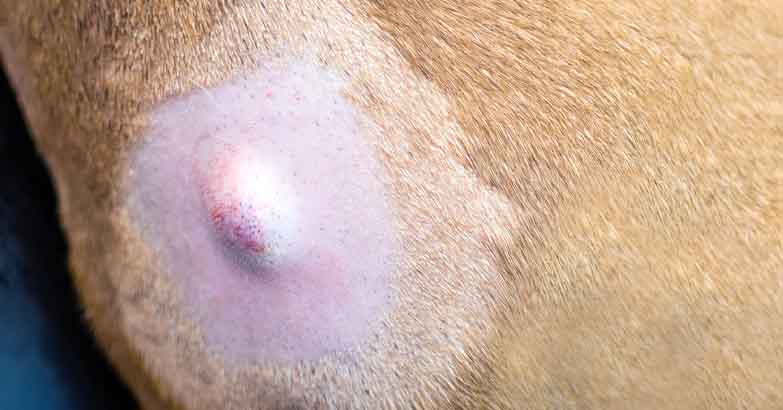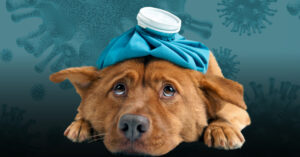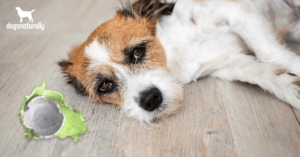Dogs are prone to getting lumps and bumps that often worry their owners. If you find your dog has a fluid-filled lump, it could be one of several types of cysts on dogs.
Here’s what you need to know to identify and manage different types of cysts on dogs.
What Is A Cyst?
A fluid-filled lump on your dog is a cyst. A cyst is a closed sac or pouch in the body that contains fluid, gas, or semi-solid material. Cysts can form anywhere on a dog’s body including the skin, paws, internal organs, and bones. They can vary in size, from very small to several inches in diameter and can be found as single or multiple cysts.
Most cysts are benign, which means they are non-cancerous and don’t spread to other parts of the body. However, some cysts can be malignant or cancerous.
What Do Cysts On Dogs Look Like?
Cysts on dogs can have different appearances depending on their location and whether they’re benign or malignant.
A smooth bump that’s round is usually a benign cyst. It can be small or large but can grow over time. If your dog has a cyst that is irregular in shape and there’s bleeding or ulceration, it might be malignant, and you should get your dog to your vet. These cysts can also grow quickly and spread to surrounding tissue.
RELATED: Common lumps and bumps on dogs …
What Causes Cysts On Dogs?
Some cysts are congenital, so they’re present at birth and develop as a result of an abnormality. Other cysts can form due to infections, inflammation or a blocked duct or gland.
Skin cysts are the most common type in dogs. They can start as a raised lump under the skin and can be caused by various factors, such as allergies, infections, or trauma. They’re usually not a problem unless they become infected or bother your dog.
Internal cysts in dogs can occur in organs such as the liver, kidneys, or ovaries. These cysts can be more serious as they can cause organ dysfunction or other health issues.
Signs Of Cysts On Dogs
Symptoms of cysts can vary depending on the location and size of the cyst. In some cases, they might not cause any symptoms at all (other than the visible cyst). Common symptoms can include pain, swelling, redness, and tenderness in the affected area.
Here are some other signs of cysts:
- A raised lump or bump under the skin, which may be visible or palpable to the touch
- Frm or soft swelling around the cyst
- Redness from being inflamed or irritated
- Discharge that’s thick, yellow or bloody
- Pain or discomfort if they’re large or form in sensitive areas
- Behavioral changes like licking or scratching, if a cyst causes pain or discomfort
Signs Your Dog Has An Internal Cyst
You can’t see this type of cyst but you might notice some of these signs. These could be symptoms of many different diseases, so it’s a good idea to see your vet:
- Loss of appetite
- Vomiting
- Abdominal pain or discomfort when you touch the abdomen
- Lethargy, lack of energy or enthusiasm
- Abdomen that is swollen, distended or bloated
- Difficulty breathing from pressure on the respiratory system
9 Types Of Cysts On Dogs
Dogs can get several types of cysts. The most common are cysts on your dog’s skin or paws.
Here are some common types of cysts on dogs:
- Epidermoid cysts are a type of skin cyst in dogs. They’re usually benign and contain a mixture of keratin and sebum, which lubricate the skin and hair.
- Sebaceous cysts (also known as sebaceous adenomas) appear in the skin when the sebaceous glands are blocked. They’re usually harmless but can become infected.
- Pilar cysts are known as trichilemmal cysts and are usually found on a dog’s head or neck. They contain keratin and often have a hard, round shape.
- Apocrine gland cysts form from the apocrine glands, which are sweat glands in the skin. You’ll usually notice them in the groin or anal area of your dog.
- Follicular cysts form around hair follicles and are usually found on your dog’s face, neck or trunk.
- Ovarian cysts occur in the ovaries of female dogs. They’re usually benign but can cause hormonal imbalances and affect a dog’s reproductive health.
- Kidney cysts form in the kidneys and can affect a dog’s kidney function if they become large or numerous.
- Mast cell tumors are cancerous tumors of the skin. They can be aggressive and spread quickly to other parts of the body.
- Lipomas are fatty tumors that develop under the skin. While most lipomas are harmless, they can become large and uncomfortable for your dog.
RELATED: Types of dog skin cancer …
Benign Cysts On Dogs
Benign cysts don’t usually need to be removed. But these are the things to watch for:
- Discomfort or pain to the dog because of where it’s located.
- Infected cyst.
- A cyst growing quickly may be a sign of a more serious condition, such as a tumor, so it needs further diagnosis.
- Cyst is in a sensitive area such as the eyelid or around the anus, and needs to be monitored to ensure there are no complications or discomfort.
Cyst On Dog Paw
A cyst on your dog’s paw may be quite noticeable. You might see your dog licking or chewing it, and it can cause him to limp. You’ll need to keep your dog’s paw clean and dry to prevent infection and promote healing.
Diagnosis of Cysts On Dogs
It’s hard to tell visually whether a cyst is benign or malignant so you it’s a good idea to ask your veterinarian to check it. Here’s how veterinarians diagnosed cysts …
- Physical examination of your dog, feeling for any lumps or bumps under the skin. She may record the location, size, and texture of any suspected cysts.
- A fine needle aspirate is when a small needle is inserted into the cyst to extract the fluid or cells inside. The sample is examined under a microscope to determine if it is something more serious.
- If the cyst is large or your vet suspects it may be cancerous, she may recommend a biopsy where a small piece of the cyst is removed and sent to a laboratory for further testing.
- In some cases, an ultrasound, X-ray, or CT scan may be done to get a better look at the cyst and determine its location, size, and whether it has spread to other parts of the body.
Treatment may include monitoring the cyst or draining it but surgical removal isn’t necessary unless it’s bothering your dog.
Should You Aspirate A Cyst On Dogs?
Aspirating a cyst can have potential risks and complications such as:
- Infection if the needle or the area around the cyst isn’t properly sterilized.
- Bleeding can happen if the cyst is located near a blood vessel or other vital structures.
- Aspirating a cyst can cause it to rupture, which can release the contents into the surrounding tissues causing inflammation, pain and infection.
- In some cases, a cyst can reform after it’s been aspirated or if there’s an underlying condition causing the cyst to form.
- If there are cancer cells present, inserting a needle can disturb cancer cells and could cause them to spread.
RELATED: A holistic approach to dog tumors …
Natural Ways To Manage A Ruptured Cyst On A Dog
Here are some natural ways you can manage a cyst on your dog:
- Keep the area clean with warm water and a mild soap to prevent further infection and promote healing.
- Apply a warm compress to reduce inflammation and pain associated with a ruptured cyst. Soak a clean cloth in warm water and apply it to the affected area for 5-10 minutes, several times a day.
- Provide pain relief by giving your dog turmeric or ginger. These are natural anti-inflammatory agents to help reduce swelling and pain.
- Add Epsom salts to a warm bath to soothe the skin and reduce inflammation. Add 1-2 cups of Epsom salts to warm water and allow your dog to soak for 10-15 minutes.
- Use herbal remedies such as calendula, chamomile and goldenseal that have natural antibacterial and anti-inflammatory properties. Use them topically on the affected area to soothe and heal the skin. You can use tinctures diluted 50/50 with water, and it’s okay to combine all 3 together.
- Certain essential oils, such as lavender or frankincense, may have anti-inflammatory and antimicrobial properties that can soothe the skin and reduce inflammation. Don’t use these oils undiluted. Add 2-3 drops to 1 oz of a carrier oil such as almond or apricot kernel oil.
RELATED: Natural topical antibiotics for dogs …
How To Prevent Cysts On Dogs
Here are some ways to help avoid a cyst on your dog:
- Brush your dog regularly to remove loose hair and keep the follicles clear. It also prevents oil and dirt from building up and causing blockages.
- Keep your dog’s skin clean and dry to reduce moisture and bacteria.
- Check your dog for lumps and bumps and take note of any change in size or texture.
- Trauma or injury can cause cysts so monitor your dog if he’s been injured.
Always feed a fresh, whole food diet rich in antioxidants that will support your dog’s immune system and skin health.












